360° Financial Trend Detection
360° Financial Trend Detection
Every year, the complex code that runs the financial operating system of our country gets a quiet update. It doesn't arrive with a flashy keynote or a dramatic press release. It's just a set of numbers, released by the IRS, that subtly recalibrates the relationship between your work, your wealth, and your government.
Most people see these announcements and their eyes glaze over. Brackets, deductions, credits—it all feels like impenetrable jargon designed to be understood only by accountants. But I see something different. When I look at the new 2026 Tax Brackets, the first full update under the "One Big, Beautiful Bill," I don't just see numbers. I see the architecture of a new idea taking shape.
We are witnessing a fundamental shift in the philosophy behind our tax code. It's evolving from a rigid, static set of rules into something more dynamic, more responsive—almost like a piece of adaptive software designed to react to the world in real-time. This isn't just about your tax bill in 2027. This is about building a smarter, more resilient economic engine for all of us.
For decades, the biggest flaw in our tax system has been its vulnerability to a silent thief: inflation. As the cost of living went up, your paycheck might have grown to keep pace, but the tax brackets didn't always move with you. This phenomenon, "bracket creep," is when inflation pushes you into a higher tax bracket even though your actual purchasing power hasn't increased—in simpler terms, you’re getting taxed more for not actually being richer. It was a bug in the system, a hidden tax that punished people for simply treading water.
The new 2026 adjustments are more than just a patch; they represent a systemic commitment to fixing this bug. By widening every single tax bracket, the code is automatically adjusting for the economic weather. The 37% top rate, for instance, won't kick in until a single filer earns over $640,600. That’s not a tax cut in the traditional sense; it’s a correction. It’s the system recognizing that a dollar in 2026 isn't the same as a dollar in 2024.
Think of it like the suspension in a modern car. It’s not just a set of stiff springs; it’s an adaptive system that constantly reads the road and adjusts to provide a smoother ride. That’s what’s happening here. The massive increase in the standard deduction—to $32,200 for married couples and $16,100 for individuals—is the system raising the floor for everyone. It’s a built-in buffer, ensuring that a larger chunk of your essential income is shielded before the tax calculation even begins. Since nearly 90% of us take the standard deduction, this is a universal upgrade to the operating system that will touch almost every single American.

This is the kind of breakthrough that reminds me why I got into this field in the first place. It’s the application of intelligent design to a complex, human-scale problem. But what happens when this design philosophy moves beyond simple corrections and starts actively trying to build a better world?
This is where the 2026 updates get truly exciting for me. A tax code can be more than just a mechanism for collecting revenue; it can be a powerful tool for incentivizing the kind of society we want to live in. It can embed our collective values directly into our economic framework. And we're seeing the first, powerful glimmers of that right now.
Look at the employer childcare credit. It’s been expanded to a staggering $500,000 per employer. This isn't just a tweak; it's a massive, system-level signal to every company in America that providing childcare support for working parents is a national priority. The code is now actively rewarding businesses that choose to solve one of the most persistent and difficult challenges facing the modern workforce—the sheer speed and impact of this change is just staggering, it means the government is using its most powerful tool not just to tax and spend but to actively nudge corporate culture in a more humane direction.
It's a beautiful piece of social engineering. Instead of a top-down government program, it’s a decentralized incentive. It empowers businesses to find creative, local solutions that work for their employees, whether that's an on-site daycare, a subsidy, or a partnership. We see the same philosophy in the increased adoption credit and the permanent, higher estate tax exclusion. These aren't just random numbers; they are lines of code that reflect a set of values: strong families, support for children, and the ability to pass on a legacy.
Of course, no system is perfect. The changes to the Alternative Minimum Tax (AMT), which actually lower the income thresholds where exemptions phase out, show that the system is also making tough choices about fairness. It's a reminder that this is a balancing act, a constant process of calibration. But the overarching direction is undeniable. The code is no longer just a passive observer of our economy. It's becoming an active participant. This raises a profound question: if we can write code that encourages better childcare, what other societal goals could we embed into our economic OS? What about incentives for sustainable energy, lifelong learning, or community investment?
When you step back, what we’re really looking at is a paradigm shift. For a century, our tax code has been like old hardware—clunky, rigid, and requiring a full manual overhaul every few years to stay relevant. The "One Big, Beautiful Bill" and the 2026 inflation adjustments are the equivalent of a cloud-based software update. The system is now designed to learn from its environment and adjust automatically. It’s a tax code built for the 21st century—less about rigid statutes and more about responsive algorithms. This isn't just a better way to collect taxes. It’s a smarter, more hopeful way to build our collective future.